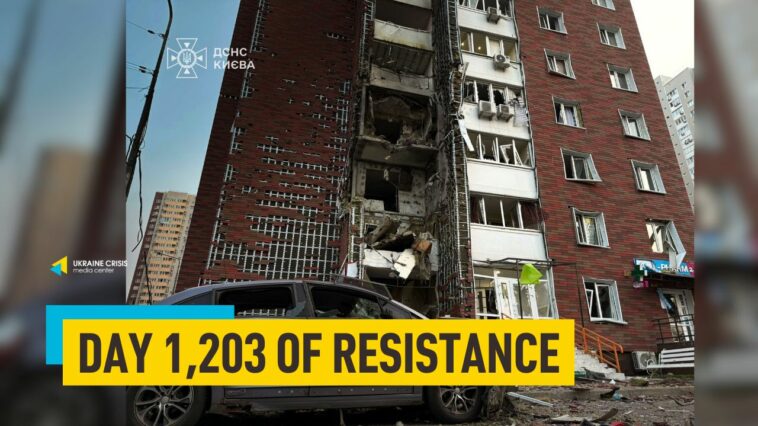Russia launches one of the largest attacks on Kyiv, a maternity ward was hit in Odesa. A Russian attack on Kyiv damages historic Saint Sophia Cathedral. Putin unleashes a summer offensive to break Ukraine, The Economist says.
Russia launches one of largest attacks on Kyiv, maternity ward hit in Odesa
Russia launched a major drone and missile strike at Ukraine overnight into Tuesday, in what appears to be one of the largest attacks of war on the capital Kyiv. Russia sent into the country 322 Shahed and decoy drones, two KN-23 ballistic missiles from the Voronezh region and five Iskander-K cruise missiles from the Kursk region, the Ukrainian Air Force said. The drones were launched from the area of Russia’s Kursk, Shatalavo, Oryol, Millerovo and Primorsko-Akhtarsk. Main target for the attack was Kyiv, it added.
Ukraine’s military said it had intercepted all seven missiles and shot down or otherwise neutralized 277 drones. The Air Force and other branches of the Ukrainian military deployed aircraft, surface-to-air missile troops, electronic warfare and drone units, and mobile teams to repel the attack. The drones hit target in 11 locations and the falling debris fell in 16 other places.
One person was killed and four others injured in Kyiv. Seven districts of the capital were hit by the attacks and falling debris. High-rise buildings, homes, cars and warehouses were left burning. Black smoke floated over the city.
In Odesa, Russian attacks killed two people and wounded nine others. One more person had an acute stress reaction. Among the buildings hit in the city were a maternity hospital, an emergency medical center and a railway station, officials said.
Russian attack on Kyiv damages historic Saint Sophia Cathedral
A Russian attack on Kyiv on Tuesday damaged Saint Sophia Cathedral, Ukraine’s Minister of Culture and Strategic Communications, Mykola Tochytskyi said.
“Last night, the enemy struck at the very heart of our identity again,” Tochytskyi wrote on Facebook about the UNESCO world heritage site located in the historic center. “Damaged Saint Sophia Cathedral is a shrine that has survived centuries and symbolizes the birth of our statehood. A blast wave has damaged the cornice on the main apse of the national heritage structure. This 11th-century church is the soul of all Ukraine,” he said.
He added that the attacks also struck the Odesa Film Studios, damaging pavilions, warehouses, set decorations and vehicles.
Set decorations for the film “Dovzhenko,” a work-in-progress about Ukraine’s acclaimed film director, were “completely destroyed.”
“Russia is not only at war with our cities — it is waging a war against our culture, memory and future,” Tochytskyi said.
A Russian drone and missile attack on Kyiv also damaged a building near the EU Delegation office, EU Ambassador to Ukraine, Katarína Mathernová, said.
“Hundreds of Shahed drones and missiles. Another sleepless night. Fires across Kyiv. A building next to the EU Delegation [office] was badly damaged. And still, people go to work in the morning. Russia will not break them. Air defence saves lives. Endless thanks to defenders & rescuers,” Mathernová said on X.
Putin unleashes a summer offensive to break Ukraine, The Economist says
Kostiantynivka and Pokrovsk could be the centre of Russia’s summer campaign, The Economist said on Sunday, citing Ukrainian intelligence. The paragraphs below are quoted from the article.
In the last two weeks there have been record-breaking Russian missile strikes on Ukrainian cities and spectacular Ukrainian drone raids on Russia’s strategic bomber force, deep inside its borders. But all this is merely a prelude to the main event: a large-scale summer offensive by Russia that aims to break Ukrainian morale and deliver president Vladimir Putin a symbolic victory at almost any cost.
Ukrainian intelligence believe that Kostiantynivka and neighbouring Pokrovsk will be the centre of Russia’s summer campaign. There are concerns about the north-eastern province of Sumy too. Russia has massed 50,000 troops there, and is advancing slowly towards the provincial capital in a mirror of Ukraine’s own cross-border operation last year.
For the first time since the war began, Russia is gaining nearly as much ground there in the north as it is in the main Donbas theatre, largely because it is making light work of fortifications unsuited to drone warfare.
Military sources say they still expect that once Russia establishes a so-called buffer zone it will shift focus to the Donbas and Zaporizhia fronts to the south—continuing the attritional warfare that has turned the region into a pockmarked wasteland.
Ukrainian sources claim that captured Russian officers tell them the summer campaign is being presented as “one last push”, to break Ukraine’s morale.
Mykhailo Kmetiuk, the commander of Typhoon, an elite unmanned-systems unit operating near Pokrovsk, says the Russians continue to plan such operations only because commanders do not spare the lives of their soldiers. Eight out of any ten of the new recruits are eventually killed on the battlefield, he claims, yet there is no realistic end to the waves of Russians. Russia is consistently recruiting 10,000-15,000 more men per month than Ukraine, and doing it by offering big sign-on bonuses rather than relying on the conscription that is proving so divisive in Ukraine.
Some Ukrainians are sceptical that Russia can ever break through. The nature of the fighting—in small dismounted groups to mitigate the risk from drones—means that Russian progress is never quick, and losses are high.
The probable result of Russia’s summer offensive remains uncomfortable: no clear victory or defeat, but with Mr Putin able to point to some shift in the map that may be enough to encourage him to keep fighting. Once the fighting stabilises after the summer offensive is over, a window of diplomacy might become possible again.

